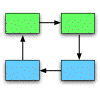
Problems for
Intermediate Methods in Theoretical Physics
Edward F. Redish
 |
Problems for |
| (a) Consider a vector describing an object's position in a two space: We want to consider the object moving around the origin in a circle, so it's distance from the origin  is a constant, even though x(t) and y(t) are functions of time. Let's create a new polar coordinate basis, |

|
(c) Now consider that the particle is moving in the circle determined by the polar equations
where ω is a constant. Construct the vector velocity by differentiating ![]() with respect to time. Do it in two ways: first by differentiating the expression for the vector in terms of of the x-y basis and second by differentiating the expression for the vector in terms of the r-θ basis. Show that the answers you get are the same.
with respect to time. Do it in two ways: first by differentiating the expression for the vector in terms of of the x-y basis and second by differentiating the expression for the vector in terms of the r-θ basis. Show that the answers you get are the same.
| University of Maryland | Physics Department | Physics 374 Home |
|---|---|---|
 |
 |
 |
Last revision 4. November, 2004.